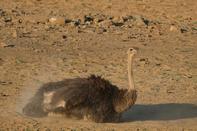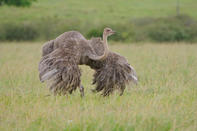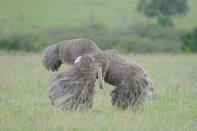Conserving Moisture

Ostriches are the only birds, and animals except for camels, that do not exhale moisture-saturated breath like other creatures. The long neck, trachea, and the wide nasal passages are believed to cool the air being breathed out which reduces the water vapour content to only about 87%.
In this way ostriches can reduce the potential of dehydrating in the hot open areas where they live. Their long necks make drinking difficult and as such they must conserve water in their bodies and satisfy most of their water requirements through the food they eat.
Like other birds, ostriches use gular fluttering to cool down on exceptionally hot days. This is the bird equivalent of panting but is much less energy expensive.
The gular skin sits towards the back of a bird’s mouth and is well supplied with blood capillaries. By fluttering this skin with the beak ajar, the blood in the capillaries is cooled by air pumping over the gular area.
Own Shade Provided
Ostriches use their wings as umbrellas when it gets very hot. Beneath their wings their thighs are naked. By lifting the wings and back feathers away from the body slightly, the smallest of breezes offers relief by moving hot air away from the skin.
They also use their wings to shade their chicks. The feathers can be used in reverse as well affording them a blanket on cold nights when they will lie down and tuck the naked legs underneath the insulating feathers.

